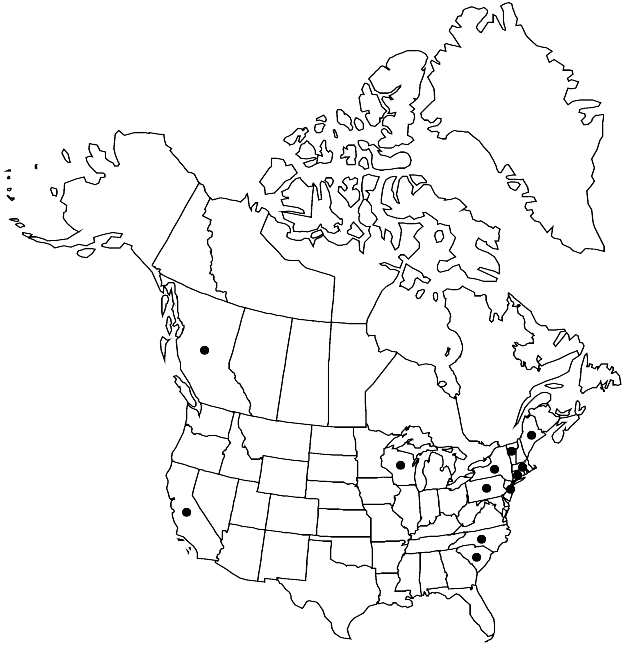Difference between revisions of "Reseda odorata"
Amoen. Acad. 3: 51. 1756.
FNA>Volume Importer |
imported>Volume Importer |
||
| (5 intermediate revisions by 2 users not shown) | |||
| Line 8: | Line 8: | ||
}} | }} | ||
|common_names=Fragrant or garden or sweet mignonette;mignonette-odorante | |common_names=Fragrant or garden or sweet mignonette;mignonette-odorante | ||
| + | |special_status={{Treatment/ID/Special_status | ||
| + | |code=I | ||
| + | |label=Introduced | ||
| + | }} | ||
|basionyms= | |basionyms= | ||
|synonyms= | |synonyms= | ||
| Line 24: | Line 28: | ||
|elevation=0-100 m | |elevation=0-100 m | ||
|distribution=B.C.;Calif.;Conn.;Maine;Mass.;N.J.;N.Y.;N.C.;Pa.;S.C.;Vt.;Wis.;n Africa. | |distribution=B.C.;Calif.;Conn.;Maine;Mass.;N.J.;N.Y.;N.C.;Pa.;S.C.;Vt.;Wis.;n Africa. | ||
| + | |introduced=true | ||
|discussion=<p><i>Reseda odorata</i> is known primarily as cultivated plants, probably of artificial hybrid origin (S. Martín-Bravo et al. 2007). Probably originating in the southeastern Mediterranean basin (M. S. Abdallah and H. C. D. de Wit 1978), it has been grown in gardens for centuries for its fragrant flowers. The perfume industry has used the essence of the flowers. Now subcosmopolitan, <i>R. odorata</i> escapes from cultivation occasionally but is rarely found naturalized. It is far less common in the flora area than the other species of the genus.</p> | |discussion=<p><i>Reseda odorata</i> is known primarily as cultivated plants, probably of artificial hybrid origin (S. Martín-Bravo et al. 2007). Probably originating in the southeastern Mediterranean basin (M. S. Abdallah and H. C. D. de Wit 1978), it has been grown in gardens for centuries for its fragrant flowers. The perfume industry has used the essence of the flowers. Now subcosmopolitan, <i>R. odorata</i> escapes from cultivation occasionally but is rarely found naturalized. It is far less common in the flora area than the other species of the genus.</p> | ||
|tables= | |tables= | ||
| Line 33: | Line 38: | ||
-->{{#Taxon: | -->{{#Taxon: | ||
name=Reseda odorata | name=Reseda odorata | ||
| − | |||
|authority=Linnaeus | |authority=Linnaeus | ||
|rank=species | |rank=species | ||
| Line 48: | Line 52: | ||
|publication title=Amoen. Acad. | |publication title=Amoen. Acad. | ||
|publication year=1756 | |publication year=1756 | ||
| − | |special status= | + | |special status=Introduced |
| − | |source xml=https:// | + | |source xml=https://bitbucket.org/aafc-mbb/fna-data-curation/src/2e0870ddd59836b60bcf96646a41e87ea5a5943a/coarse_grained_fna_xml/V7/V7_249.xml |
|genus=Reseda | |genus=Reseda | ||
|species=Reseda odorata | |species=Reseda odorata | ||
Latest revision as of 22:32, 5 November 2020
Plants annual 25–60(–80) cm, glabrous or puberulent. Stems erect or ascendent, branched. Leaves: blade spatulate to obovate, 3–5(–7) × 1–2 cm, margins entire or ternately lobed (distal cauline lobes 1–3 pairs). Racemes (3–)5–20 cm; bracts persistent, lanceolate-attenuate, 2–3 mm. Pedicels 4–6 mm (7–16 mm in fruit). Flowers (very fragrant); sepals persistent, 6, reflexed in fruit, narrowly elliptic to spatulate, 2.5–4.5(–6.5) mm; petals 6, white or light yellow, 2.5–4.5 mm, clawed, adaxial ones trisect, lateral lobes deeply laciniate; stamens 20–25; filaments deciduous, 2–3 mm, usually papillose; intrastaminal nectary-discs puberulous to velutinous; anthers 1.5–2 mm; placenta entire. Capsules deflexed or pendent, 3-carpelled, broadly cylindric to subglobose, 5–9 × 4–6 mm, apically 3-toothed, walls glabrous, ribs minutely scabrid. Seeds 1.5–1.8(–2.2) mm, dull, undulate-rugose. 2n = 12.
Phenology: Flowering (Feb-)Jun–Oct.
Habitat: Disturbed soils
Elevation: 0-100 m
Distribution

Introduced; B.C., Calif., Conn., Maine, Mass., N.J., N.Y., N.C., Pa., S.C., Vt., Wis., n Africa.
Discussion
Reseda odorata is known primarily as cultivated plants, probably of artificial hybrid origin (S. Martín-Bravo et al. 2007). Probably originating in the southeastern Mediterranean basin (M. S. Abdallah and H. C. D. de Wit 1978), it has been grown in gardens for centuries for its fragrant flowers. The perfume industry has used the essence of the flowers. Now subcosmopolitan, R. odorata escapes from cultivation occasionally but is rarely found naturalized. It is far less common in the flora area than the other species of the genus.
Selected References
None.